A Comprehensive Review on Design, Monitoring, and Failure in Fixed Offshore Platforms
Abstract
:1. Introduction
2. Design and Monitoring
3. Reliability and Failure Probability
4. Conclusions
- Research shows that Europe has made a targeted and strong investment in generating electricity through wind turbines installed in offshore structures. In the next few years, it will increase its dependence on this industry five times what it is now. This requires extensive research on this subject, and scholars will pay more attention to it.
- One of the most evident environmental problems of wind turbines is dealing with migratory birds. Therefore, the issue of bird migration and their routes should be considered in the design of wind turbine installation by engineers. In this regard, the problems of offshore wind turbines are far less than those of wind turbines on land.
- One of the most essential design criteria in offshore structures, especially wind turbines, is to consider the dynamic behavior of the structure under wind loads and forces from sea wave clashes. It is also very important to study the corrosion phenomenon due to the salinity of seawater. In addition, the study of the simultaneous impact of this phenomenon and the previously mentioned dynamic forces is very complex, which makes it necessary to accurately estimate the service life of equipment. In addition, the possible occurrence of some events should be considered according to the geographical situations like storms, earthquakes, and freeze.
- One of the most common events that cause damage and shortens the life of naval platforms is the possibility of ships and other floating objects colliding with the platforms, because ships are constantly moving, docking to carry oil/gas and staff, etc.
- The most sensitive parts of marine structures, which are prone to failure under cyclic fatigue loads are different types of welds and joints.
- There are different methods to improve the strength of offshore platforms, including, eliminating irregularities, adding additional parts, use of energy dissipation systems, etc., but in all of them, special attention should be paid to the problems caused by asymmetry in the system.
- Assessing and monitoring the health of offshore structures is crucial due to financial and human interests, so an expert team should be involved in this area. On the other hand, this issue is more important than the design stage. The design process is done in one step and, after the construction, the work of that team is completed, but the inspection team in each period addresses changes in working conditions and equipment health and must make new decisions. In other words, the task of the inspection team is dynamic. Therefore, different methods for evaluating these structures are presented and developed by researchers.
- This comprehensive review helps and guides scholars, engineers, and designers of offshore platforms to find suitable ideas and appropriate methods to advance their projects.
- Additionally, according to the literature review, there are several valuable suggestions for future work, including:
- The lack of using artificial intelligence methods in this scope is noticeable and should be considered, because these methods have remarkable potentials in predicting affected factors and solving problems to enhance the quality of evaluations.
- By employing deep learning machine tools, the life and damage in large structures can be predicted and heavy repair costs and long downtime for replacement of damaged parts can be avoided.
Author Contributions
Funding
Informed Consent Statement
Data Availability Statement
Acknowledgments
Conflicts of Interest
References
- McClelland, B.; Reifel, M.D. Planning and Design of Fixed Offshore Platforms; U.S. Department of Energy: Washington, DC, USA, 1986.
- Omidi Bidgoli, M.; Kashyzadeh, K.R.; Rahimian Koloor, S.S.; Petrů, M.; Amiri, N. Optimum Design of Sunken Reinforced Enclosures under Buckling Condition. Appl. Sci. 2020, 10, 8449. [Google Scholar] [CrossRef]
- Bea, R.; Xu, T.; Stear, J.; Ramos, R. Wave forces on decks of offshore platforms. J. Waterw. Port Coast. Ocean Eng. 1999, 125, 136–144. [Google Scholar] [CrossRef]
- Available online: https://windeurope.org/policy/topics/offshore-wind-ports/ (accessed on 6 September 2021).
- Bailey, H.; Brookes, K.L.; Thompson, P.M. Assessing environmental impacts of offshore wind farms: Lessons learned and recommendations for the future. Aquat. Biosyst. 2014, 10, 1–13. [Google Scholar] [CrossRef] [Green Version]
- Price, S.J.; Figueira, R.B. Corrosion protection systems and fatigue corrosion in offshore wind structures: Current status and future perspectives. Coatings 2017, 7, 25. [Google Scholar] [CrossRef]
- Bea, R.G. Earthquake and wave design criteria for offshore platforms. J. Struct. Div. 1979, 105, 401–419. [Google Scholar] [CrossRef]
- Ryerson, C.C. Assessment of Superstructure Ice Protection as Applied to Offshore Oil Operations Safety: Problems, Hazards, Needs, and Potential Transfer Technologies; US Army Corps of Engineers: Wallisville, TX, USA, 2008.
- Beer, M.; Liebscher, M. Designing robust structures–a nonlinear simulation based approach. Comput. Struct. 2008, 86, 1102–1122. [Google Scholar] [CrossRef]
- Formisano, A.; Landolfo, R.; Mazzolani, F. Robustness assessment approaches for steel framed structures under catastrophic events. Comput. Struct. 2015, 147, 216–228. [Google Scholar] [CrossRef] [Green Version]
- Sarrafan, A.; Zareh, S.H.; Khayyat, A.A.A.; Zabihollah, A. Neuro-fuzzy control strategy for an offshore steel jacket platform subjected to wave-induced forces using magnetorheological dampers. J. Mech. Sci. Technol. 2012, 26, 1179–1196. [Google Scholar] [CrossRef]
- Shaterabadi, M.; Jirdehi, M.A.; Amiri, N.; Omidi, S. Enhancement the economical and environmental aspects of plus-zero energy buildings integrated with INVELOX turbines. Renew. Energy 2020, 153, 1355–1367. [Google Scholar] [CrossRef]
- Singh, H.; Gupta, M.M.; Meitzler, T.; Hou, Z.G.; Garg, K.K.; Solo, A.M.; Zadeh, L.A. Real-life applications of fuzzy logic. Adv. Fuzzy Syst. 2013, 2013, 581879. [Google Scholar] [CrossRef]
- Zhang, Y. Comparing the robustness of offshore structures with marine deteriorations—a fuzzy approach. Adv. Struct. Eng. 2015, 18, 1159–1171. [Google Scholar] [CrossRef]
- Wang, Z.; Zhang, B.; Wang, T. Mechanical test and buckling analysis of X-type grouted clamps for the offshore platform structures. IOP Conf. Ser. Mater. Sci. Eng. 2019, 474, 012015. [Google Scholar] [CrossRef]
- Wang, Z.; Wang, Q.C.; Wang, T. Mechanics Experiments and Analysis of Grouting Clamp Reinforcement to Local Defects on the Ocean Jacket. J. Phys. Conf. Ser. 2018, 1087, 042050. [Google Scholar] [CrossRef]
- Moharrami, M.; Tootkaboni, M. Reducing response of offshore platforms to wave loads using hydrodynamic buoyant mass dampers. Eng. Struct. 2014, 81, 162–174. [Google Scholar] [CrossRef]
- Jafarabad, A.; Kashani, M.; Parvar, M.R.A.; Golafshani, A.A. Hybrid damping systems in offshore jacket platforms with float-over deck. J. Constr. Steel Res. 2014, 98, 178–187. [Google Scholar] [CrossRef]
- Zhang, B.L.; Liu, Y.J.; Han, Q.L.; Tang, G.Y. Optimal tracking control with feedforward compensation for offshore steel jacket platforms with active mass damper mechanisms. J. Vib. Control 2016, 22, 695–709. [Google Scholar] [CrossRef]
- Zhang, B.L.; Liu, Y.J.; Ma, H.; Tang, G.Y. Discrete feedforward and feedback optimal tracking control for offshore steel jacket platforms. Ocean Eng. 2014, 91, 371–378. [Google Scholar] [CrossRef]
- Asgarian, B.; Aghakouchak, A.; Alanjari, P.; Assareh, M. Incremental dynamic analysis of jacket type offshore platforms considering soil-pile interaction. In Proceedings of the 14th World Conference on Earthquake Engineering, Beijing, China, 12–17 October 2008; pp. 12–17. [Google Scholar]
- Bea, R. Criteria for design and requalification of platforms in the bay of Campeche, Mexico. J. Waterw. Port Coast. Ocean Eng. 2000, 126, 254–262. [Google Scholar] [CrossRef]
- Zhang, D.; Yue, Q. Major challenges of offshore platforms design for shallow water oil and gas field in moderate ice conditions. Ocean Eng. 2011, 38, 1220–1224. [Google Scholar] [CrossRef]
- Wang, S.; Yue, Q.; Zhang, D. Ice-induced non-structure vibration reduction of jacket platforms with isolation cone system. Ocean Eng. 2013, 70, 118–123. [Google Scholar] [CrossRef]
- Wang, S.Q.; Li, N. Semi-active vibration control for offshore platforms based on LQG method. J. Mar. Sci. Technol. 2021, 21, 9. [Google Scholar]
- Wu, B.; Shi, P.; Wang, Q.; Guan, X.; Ou, J. Performance of an offshore platform with MR dampers subjected to ice and earthquake. Struct. Control Health Monit. 2011, 18, 682–697. [Google Scholar] [CrossRef]
- Mostafa, Y.E.; El Naggar, M.H. Response of fixed offshore platforms to wave and current loading including soil–structure interaction. Soil Dyn. Earthq. Eng. 2004, 24, 357–368. [Google Scholar] [CrossRef]
- Azman, N.U.; Husain, M.K.A.; Zaki, N.I.M.; Soom, E.M.; Mukhlas, N.A.; Ahmad, S.Z.A.S. Structural Integrity of Fixed Offshore Platforms by Incorporating Wave-in-Deck. J. Mar. Sci. Eng. 2021, 9, 1027. [Google Scholar] [CrossRef]
- Hosseini, S.; Zolghadr, A. Optimization of an offshore jacket-type structure using meta-heuristic algorithms. Iran Univ. Sci. Technol. 2017, 7, 565–577. [Google Scholar]
- Zhang, X.; Song, X.; Qiu, W.; Yuan, Z.; You, Y.; Deng, N. Multi-objective optimization of Tension Leg Platform using evolutionary algorithm based on surrogate model. Ocean Eng. 2018, 148, 612–631. [Google Scholar] [CrossRef] [Green Version]
- Abou El-Makarem, M.; Elshafey, A.A.; Abdel-Salam, A.; Mokhtar, B.I.T. Topology Optimization of Fixed Offshore Platform under Earthquake Loading in Gulf of Suez. IOSR J. Mech. Civ. Eng. 2019, 16, 58–71. [Google Scholar]
- Tian, X.; Wang, Q.; Liu, G.; Liu, Y.; Xie, Y.; Deng, W. Topology optimization design for offshore platform jacket structure. Appl. Ocean Res. 2019, 84, 38–50. [Google Scholar] [CrossRef]
- Deng, W.; Tian, X.; Han, X.; Liu, G.; Xie, Y.; Li, Z. Topology optimization of jack-up offshore platform leg structure. Proc. Inst. Mech. Eng. Part M J. Eng. Marit. Environ. 2021, 235, 165–175. [Google Scholar] [CrossRef]
- Babaei, S.; Amirabadi, R.; Sharifi, M.; Ventura, C. Optimal probabilistic seismic demand model for fixed pile-founded offshore platforms considering soil-pile-structure interaction. Structures 2021, 33, 4330–4343. [Google Scholar] [CrossRef]
- Ajamy, A.; Asgarian, B.; Ventura, C.; Zolfaghari, M. Seismic fragility analysis of jacket type offshore platforms considering soil-pile-structure interaction. Eng. Struct. 2018, 174, 198–211. [Google Scholar] [CrossRef]
- Mazaheri, P.; Asgarian, B.; Gholami, H. Assessment of strengthening, modification, and repair techniques for aging fixed offshore steel platforms. Appl. Ocean Res. 2021, 110, 102612. [Google Scholar] [CrossRef]
- Samarakoon, S.M.; Ratnayake, R.C. Strengthening, modification and repair techniques’ prioritization for structural integrity control of ageing offshore structures. Reliab. Eng. Syst. Saf. 2015, 135, 15–26. [Google Scholar] [CrossRef]
- Skafte, A.; Tygesen, U.T.; Brincker, R. Expansion of mode shapes and responses on the offshore platform Valdemar. Dyn. Civ. Struct. 2014, 4, 35–41. [Google Scholar]
- Ghadimi, B.; Taghikhany, T. Dynamic response assessment of an offshore jacket platform with semi-active fuzzy-based controller: A case study. Ocean Eng. 2021, 238, 109747. [Google Scholar] [CrossRef]
- Jiang, X.; Han, Q.L. On H∞ control for linear systems with interval time-varying delay. Automatica 2005, 41, 2099–2106. [Google Scholar] [CrossRef]
- Zhang, B.L.; Huang, Z.W.; Han, Q.L. Delayed non-fragile H∞ control for offshore steel jacket platforms. In Proceedings of the IECON 2012—38th Annual Conference on IEEE Industrial Electronics Society, Montreal, QC, Canada, 15–28 October 2012; pp. 2216–2221. [Google Scholar]
- Zhang, B.L.; Tang, G.Y. Active vibration H∞ control of offshore steel jacket platforms using delayed feedback. J. Sound Vib. 2013, 332, 5662–5677. [Google Scholar] [CrossRef]
- Zhang, B.L.; Han, Q.L. Robust sliding mode H∞ control using time-varying delayed states for offshore steel jacket platforms. In Proceedings of the 2013 IEEE International Symposium on Industrial Electronics, Taipei, Taiwan, 28–31 May 2013; pp. 1–6. [Google Scholar]
- Yang, J.S. Robust mixedH2/H∞ active control for offshore steel jacket platform. Nonlinear Dyn. 2014, 78, 1503–1514. [Google Scholar] [CrossRef]
- Sakthivel, R.; Selvaraj, P.; Mathiyalagan, K.; Park, J.H. Robust fault-tolerant H∞ control for offshore steel jacket platforms via sampled-data approach. J. Frankl. Inst. 2015, 352, 2259–2279. [Google Scholar] [CrossRef]
- Zhang, B.L.; Han, Q.L.; Zhang, X.M. Event-triggered H∞ reliable control for offshore structures in network environments. J. Sound Vib. 2016, 368, 1–21. [Google Scholar] [CrossRef]
- Zhang, B.L.; Feng, A.M.; Li, J. Observer-based optimal fault-tolerant control for offshore platforms. Comput. Electr. Eng. 2014, 40, 2204–2215. [Google Scholar] [CrossRef]
- Mujeeb-Ahmed, M.; Seo, J.K.; Paik, J.K. Probabilistic approach for collision risk analysis of powered vessel with offshore platforms. Ocean Eng. 2018, 151, 206–221. [Google Scholar] [CrossRef]
- Mujeeb-Ahmed, M.; Ince, S.T.; Paik, J.K. Computational models for the structural crashworthiness analysis of a fixed-type offshore platform in collisions with an offshore supply vessel. Thin-Walled Struct. 2020, 154, 106868. [Google Scholar] [CrossRef]
- Yu, Z.; Amdahl, J. Analysis and design of offshore tubular members against ship impacts. Mar. Struct. 2018, 58, 109–135. [Google Scholar] [CrossRef]
- Ahn, J.H.; Choi, W.R.; Jeon, S.H.; Kim, S.H.; Kim, I.T. Residual compressive strength of inclined steel tubular members with local corrosion. Appl. Ocean Res. 2016, 59, 498–509. [Google Scholar] [CrossRef]
- Aliev, T.; Alizada, T.; Rzayeva, N. Noise technologies and systems for monitoring the beginning of the latent period of accidents on fixed platforms. Mech. Syst. Signal Process. 2017, 87, 111–123. [Google Scholar] [CrossRef]
- Ghasemi, M.R.; Shabakhty, N.; Enferadi, M.H. Optimized SMA dampers in vibration control of jacket-type offshore structures (regular waves). Int. J. Coast. Offshore Eng. 2019, 2, 25–35. [Google Scholar] [CrossRef] [Green Version]
- Shabakhty, N.; Givkay, A.; Golara, A.; Heidari, P.S.N. Response of fixed offshore oil and gas platforms equipped with shape memory alloy elements under extreme wave loading. In Proceedings of the16th European Conference on Earthquake Engineering (16ECEE), Thessaloniki, Greece, 18–21 June 2018. [Google Scholar]
- Zareie, S.; Zabihollah, A. A semi-active SMA-MRF structural stability element for seismic control in marine structures. Appl. Ocean Res. 2020, 100, 102161. [Google Scholar] [CrossRef]
- Enferadi, M.H.; Ghasemi, M.R.; Shabakhty, N. Wave-induced vibration control of offshore jacket platforms through SMA dampers. Appl. Ocean Res. 2019, 90, 101848. [Google Scholar] [CrossRef]
- Kurian, V.J.; Abdul Wahab, M.M.; Kheang, T.S.; Liew, M.S. System reliability of existing jacket platform in Malaysian water (failure path and system reliability index). Appl. Mech. Mater. 2014, 567, 307–312. [Google Scholar] [CrossRef]
- Gholizad, A.; Golafshani, A.; Akrami, V. Structural reliability of offshore platforms considering fatigue damage and different failure scenarios. Ocean Eng. 2012, 46, 1–8. [Google Scholar] [CrossRef]
- Ribeiro, F.L.; Barbosa, A.R.; Neves, L.C. Application of reliability-based robustness assessment of steel moment resisting frame structures under post-mainshock cascading events. J. Struct. Eng. 2014, 140, A4014008. [Google Scholar] [CrossRef]
- Jimenez Martinez, M. Harbor and coastal structures: A review of mechanical fatigue under random wave loading. Heliyon 2021, 7, e08241. [Google Scholar] [CrossRef]
- Du, J.; Wang, H.; Wang, S.; Song, X.; Wang, J.; Chang, A. Fatigue damage assessment of mooring lines under the effect of wave climate change and marine corrosion. Ocean. Eng. 2020, 206, 107303. [Google Scholar] [CrossRef]
- Kim, D.K.; Lim, H.L.; Cho, N.K. An advanced technique to predict time-dependent corrosion damage of onshore, offshore, nearshore and ship structures: Part II—Application to the ship’s ballast tank. Int. J. Nav. Archit. Ocean Eng. 2020, 12, 645–656. [Google Scholar] [CrossRef]
- Zhang, M.; Beer, M.; Quek, S.; Choo, Y. Comparison of uncertainty models in reliability analysis of offshore structures under marine corrosion. Struct. Saf. 2010, 32, 425–432. [Google Scholar] [CrossRef]
- Mourão, A.; Correia, J.A.; Avila, B.V.; de Oliveria, C.C.; Ferradosa, T.; Carvalho, H.; Castro, J.M.; De Jesus, A.M.P. A fatigue damage evaluation using local damage parameters for an offshore structure. Proc. Inst. Civ. Eng. Marit. Eng. 2020, 173, 43–57. [Google Scholar] [CrossRef]
- Kurian, V.; Nizamani, Z.; Liew, M. Bayesian updating for probability of failure of jacket platforms in Malaysia. In Proceedings of the IEEE Business Engineering and Industrial Applications Colloquium (BEIAC), Langkawi, Malaysia, 7–9 April 2013; pp. 267–272. [Google Scholar]
- Ayob, M.; Kajuputra, A.; Mukherjee, K.; Wong, B. Global ultimate strength assessment of existing offshore jacket structures. In Proceedings of the Offshore Technology Conference—Asia, Kuala Lumpur, Malaysia, 25–28 March 2014. [Google Scholar]
- Li, P.; Lin, H.; Yang, L.; Zhang, Y.; Qi, B. Failure mode analysis and damage control for jacket platform structures. In Proceedings of the 5th International Conference on Civil, Architectural and Hydraulic Engineering (ICCAHE 2016), Zhuhai, China, 30–31 July 2016. [Google Scholar]
- Yu, S.; Zhang, D.; Yue, Q. Failure analysis of topside facilities on oil/gas platforms in the Bohai Sea. J. Mar. Sci. Eng. 2019, 7, 86. [Google Scholar] [CrossRef] [Green Version]
- Lin, H.; Yang, L.; Chen, G.; Li, P.; Qi, B. A novel methodology for structural robustness assessment of offshore platforms in progressive collapse. J. Loss Prev. Process Ind. 2019, 62, 103966. [Google Scholar] [CrossRef]
- Moradi, H.; Karimi, H.R.; KaramZadeh, N.S.; Golami, E.O.D.R. Effects of leg slope on the failure of fixed jacket platforms: A case study of south pars gas Field’s platforms. Ocean Eng. 2020, 210, 107401. [Google Scholar] [CrossRef]
- Arghavan, A.; Reza Kashyzadeh, K.; Asfarjani, A.A. Investigating effect of industrial coatings on fatigue damage. Appl. Mech. Mater. 2011, 87, 230–237. [Google Scholar] [CrossRef]
- Kashyzadeh, K.R.; Arghavan, A. Study of the effect of different industrial coating with microscale thickness on the CK45 steel by experimental and finite element methods. Strength Mater. 2013, 45, 748–757. [Google Scholar] [CrossRef]
- Khalifa, A.; Haggag, S.; Fayed, M. Fatigue assessment analysis of offshore structures with application to an existing platform in Suez Gulf, Egypt. World Appl. Sci. J. 2014, 30, 1000–1019. [Google Scholar]
- Havigh, S.N.; Askar, M.B. The process of fatigue analysis on fixed metal offshore platforms. Mar. Sci. 2017, 7, 10–16. [Google Scholar]
- Saadian, R.; Taheri, A. Fatigue damage analysis of an existing fixed offshore platform using spectral method for life extension. J. Mar. Sci. Technol. 2018, 23, 877–887. [Google Scholar] [CrossRef]
- Nabuco, B.; Tarpø, M.; Tygesen, U.T.; Brincker, R. Fatigue stress estimation of an offshore jacket structure based on operational modal analysis. Shock Vib. 2020, 2020, 7890247. [Google Scholar] [CrossRef]
- Amiri, N.; Farrahi, G.H.; Kashyzadeh, K.R.; Chizari, M. Applications of ultrasonic testing and machine learning methods to predict the static & fatigue behavior of spot-welded joints. J. Manuf. Process. 2020, 52, 26–34. [Google Scholar]
- Motlagh, A.A.; Shabakhty, N.; Kaveh, A. Design optimization of jacket offshore platform considering fatigue damage using Genetic Algorithm. Ocean Eng. 2021, 227, 108869. [Google Scholar] [CrossRef]
- Farrahi, G.H.; Chamani, M.; Kashyzadeh, K.R.; Mostafazadeh, A.; Mahmudi, A.H.; Afshin, H. Failure analysis of bolt connections in fired heater of a petrochemical unit. Eng. Fail. Anal. 2018, 92, 327–342. [Google Scholar] [CrossRef]
- Ahmadi, A.; Farrahi, G.H.; Reza Kashyzadeh, K.; Azadi, S.; Jahani, K. A comparative study on the fatigue life of the vehicle body spot welds using different numerical techniques: Inertia relief and Modal dynamic analyses. Frat. Integrità Strutt. 2020, 14, 67–81. [Google Scholar]
- Farrahi, G.H.; Ahmadi, A.; Reza Kashyzadeh, K. Simulation of vehicle body spot weld failures due to fatigue by considering road roughness and vehicle velocity. Simul. Model. Pract. Theory 2020, 105, 102168. [Google Scholar] [CrossRef]
- Hammerstad, B.H.; Schafhirt, S.; Muskulus, M. On fatigue damage assessment for offshore support structures with tubular joints. Energy Procedia 2016, 94, 339–346. [Google Scholar] [CrossRef] [Green Version]
- Ghafarallahi, E.; Farrahi, G.H.; Amiri, N. Acoustic simulation of ultrasonic testing and neural network used for diameter prediction of three-sheet spot welded joints. J. Manuf. Process. 2021, 64, 1507–1516. [Google Scholar] [CrossRef]
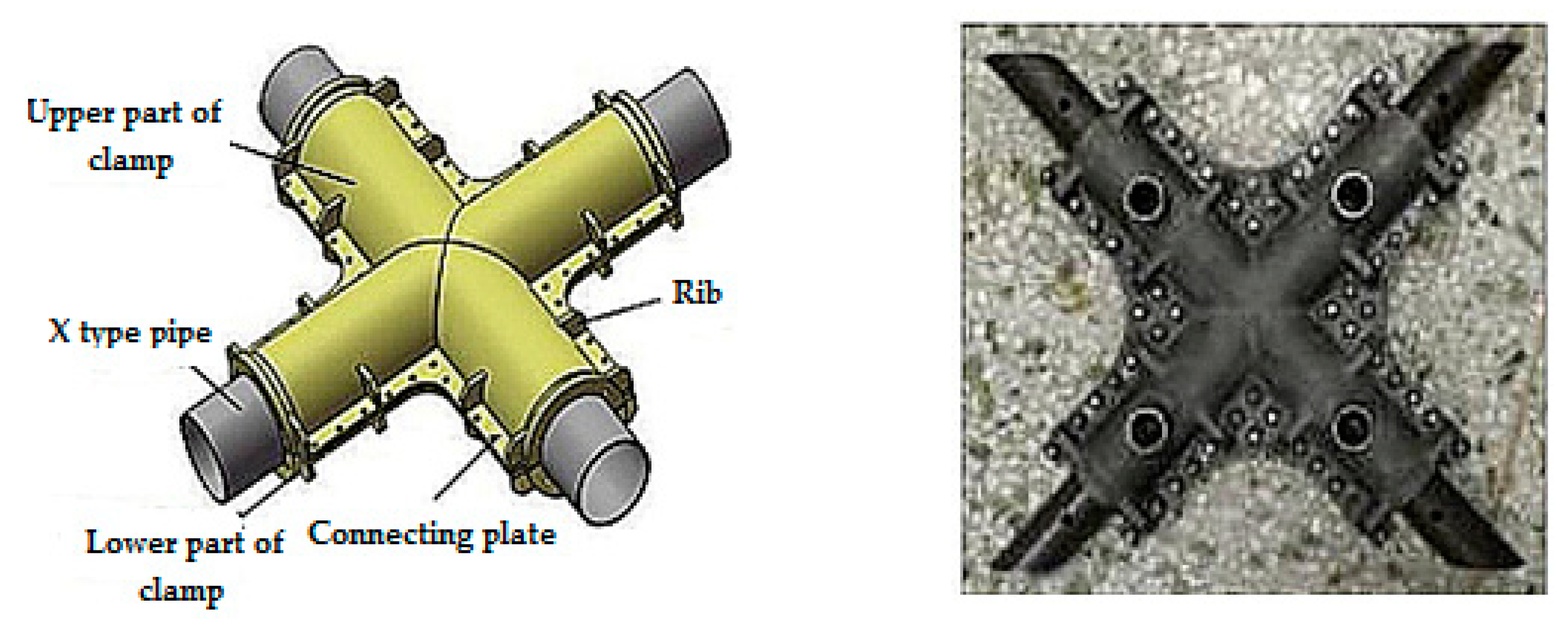


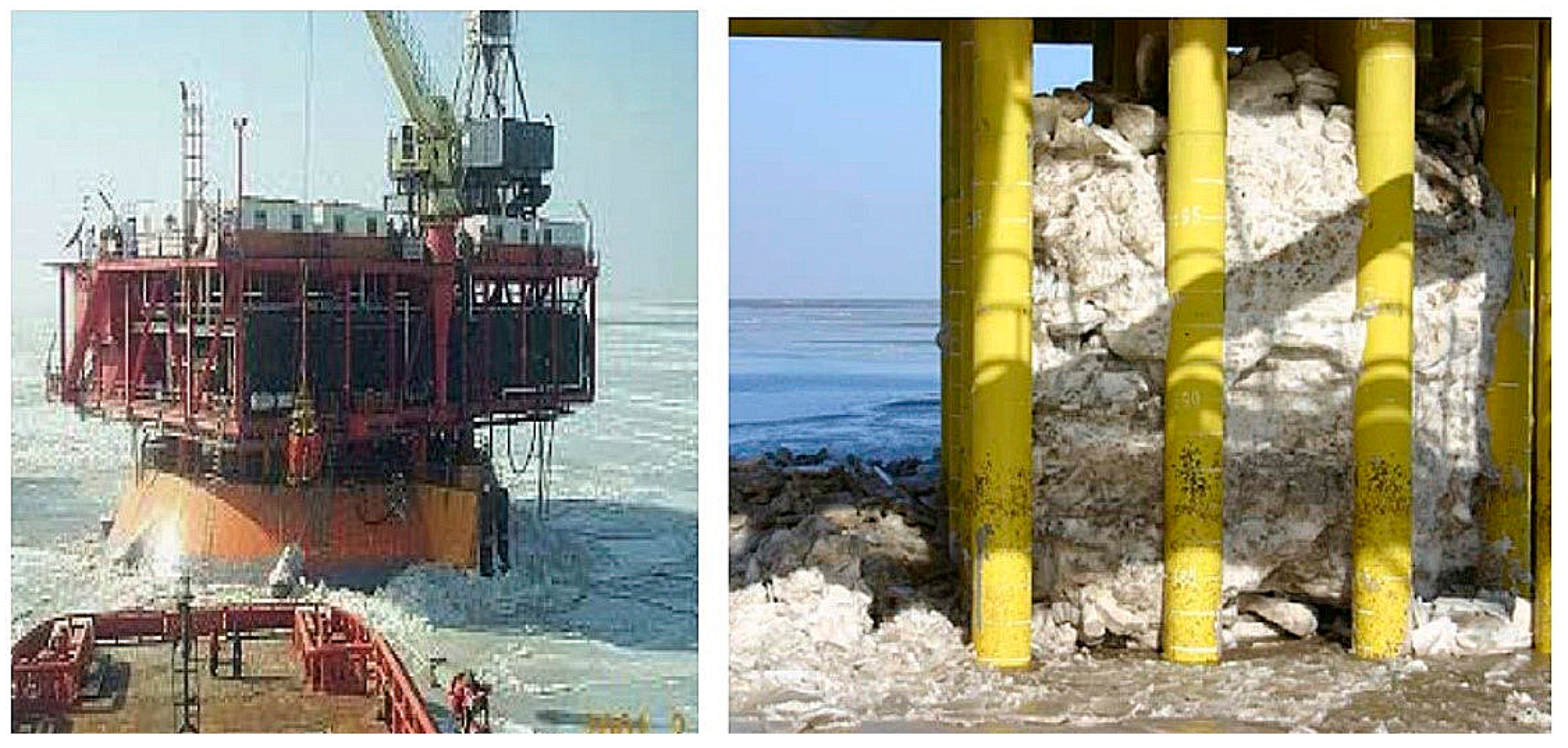

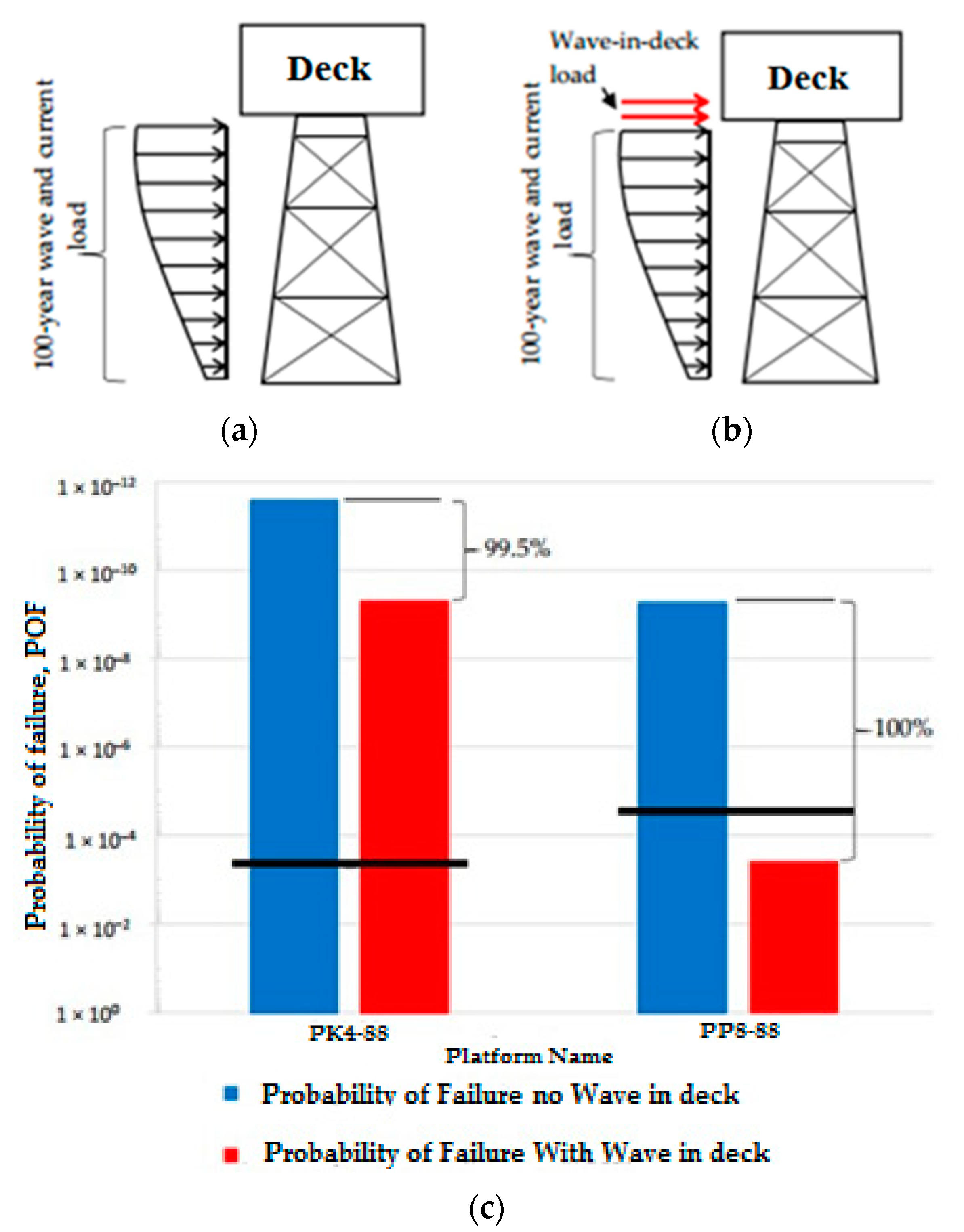

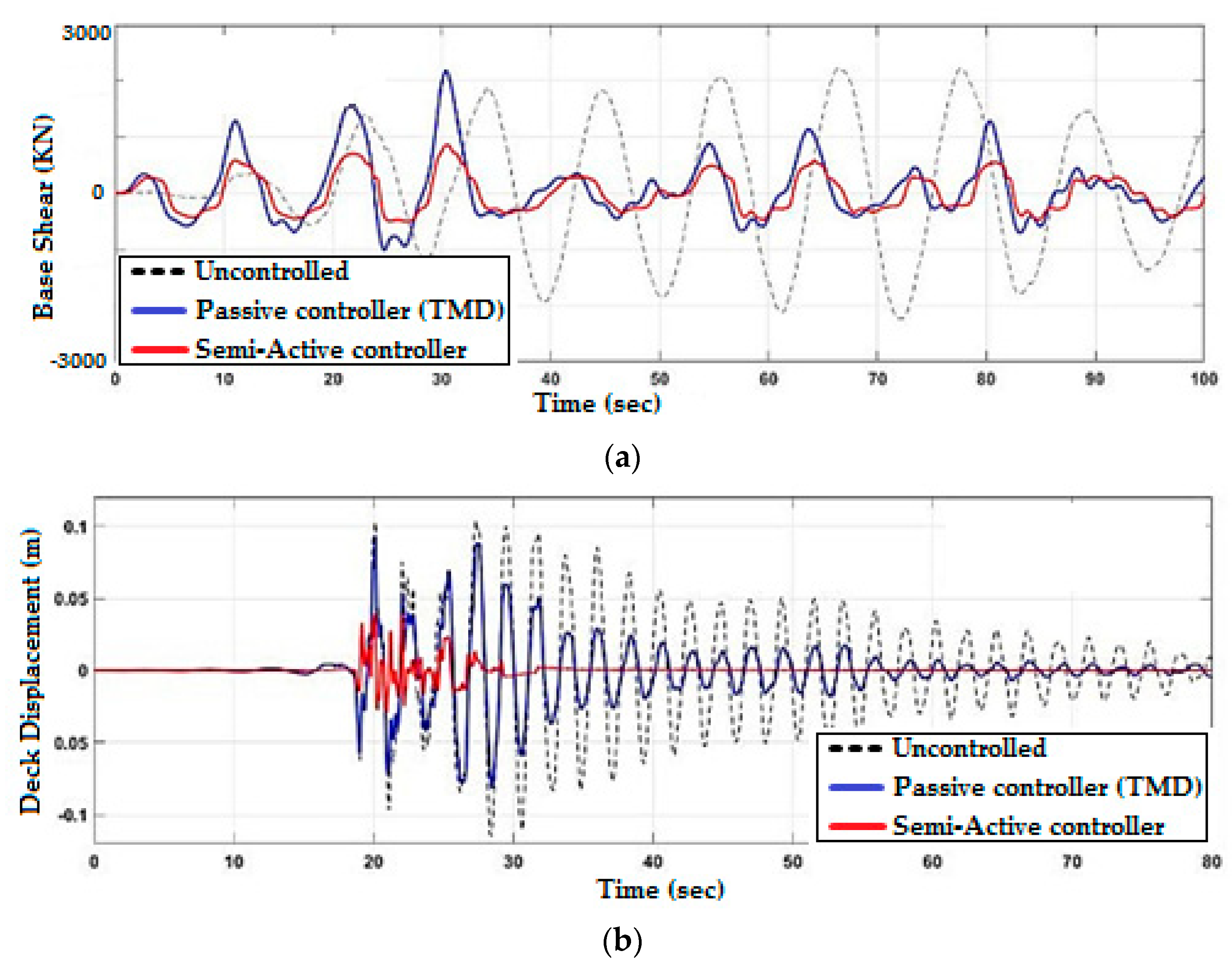
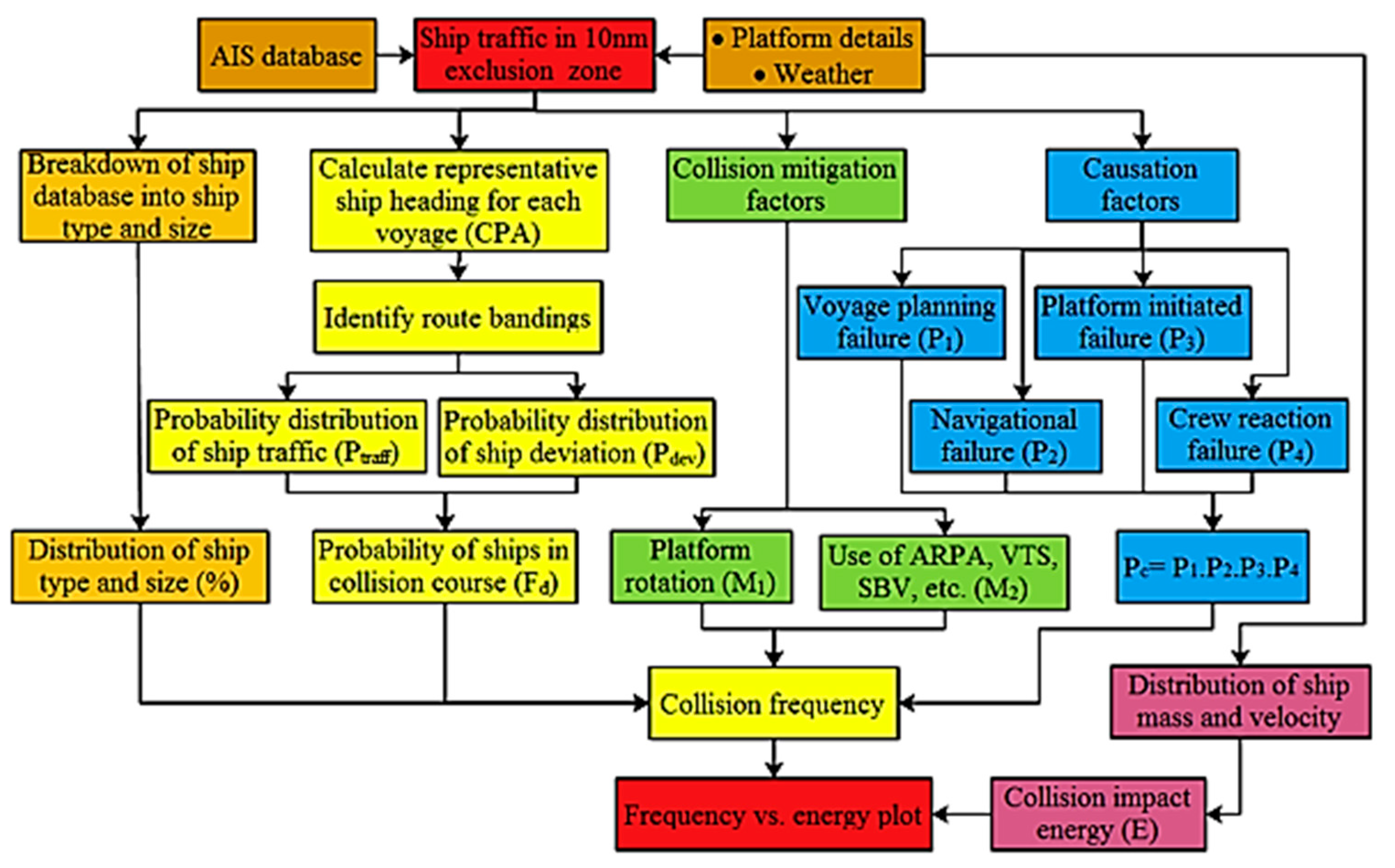


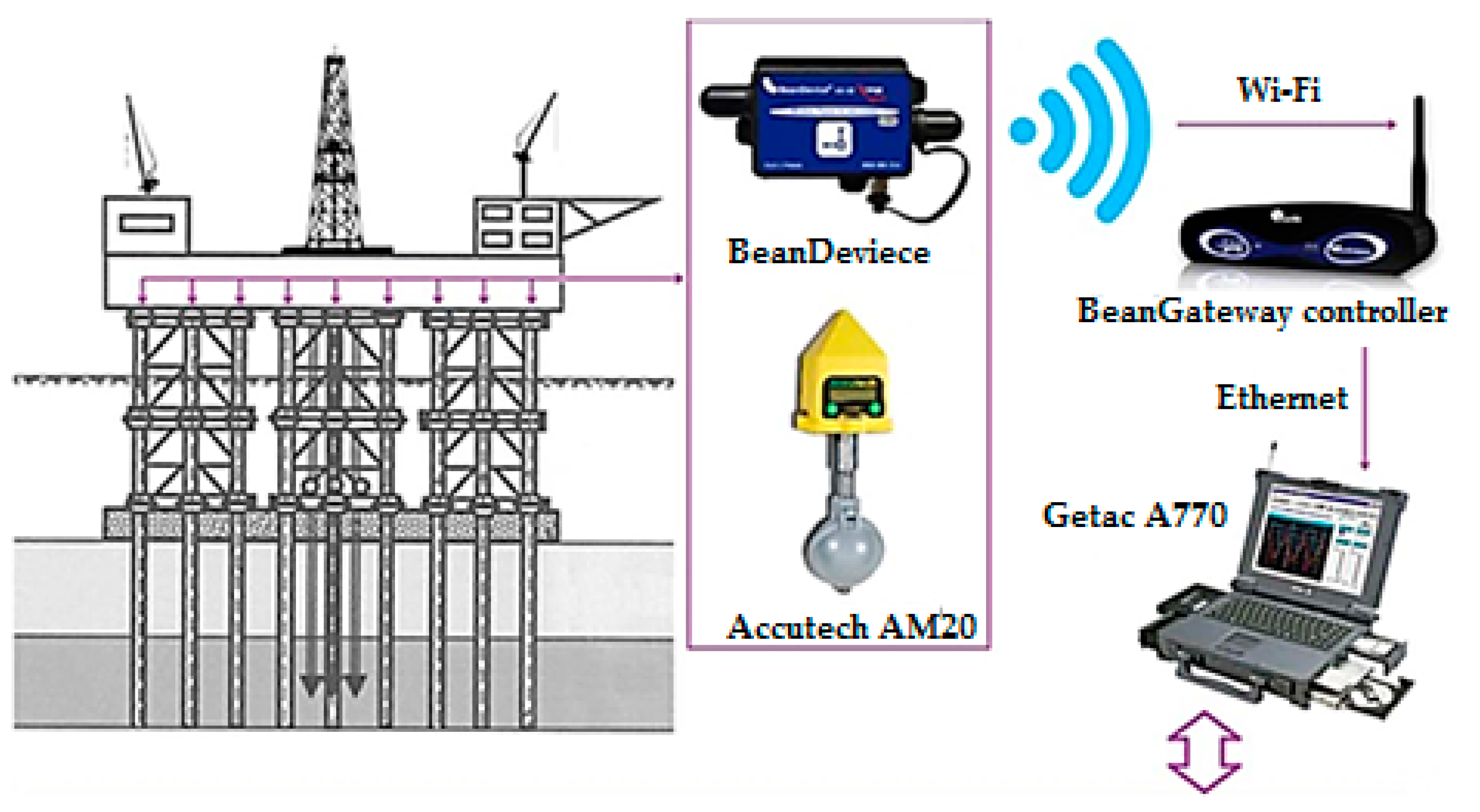
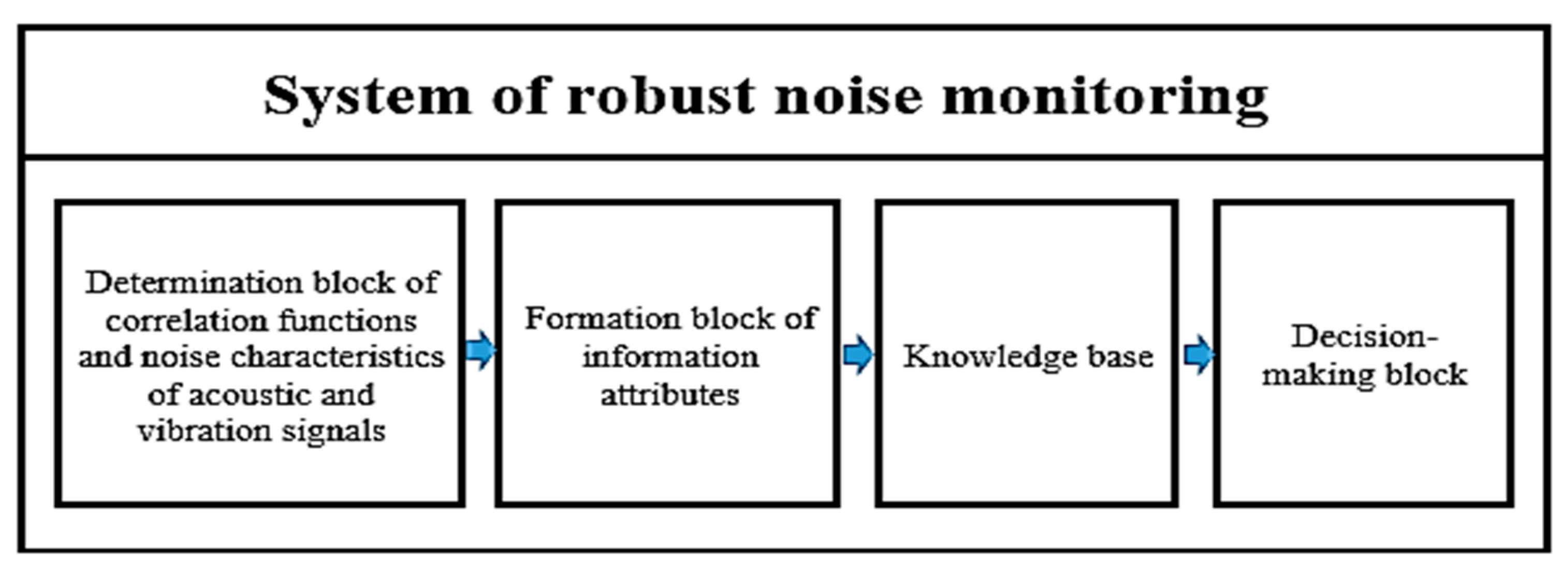


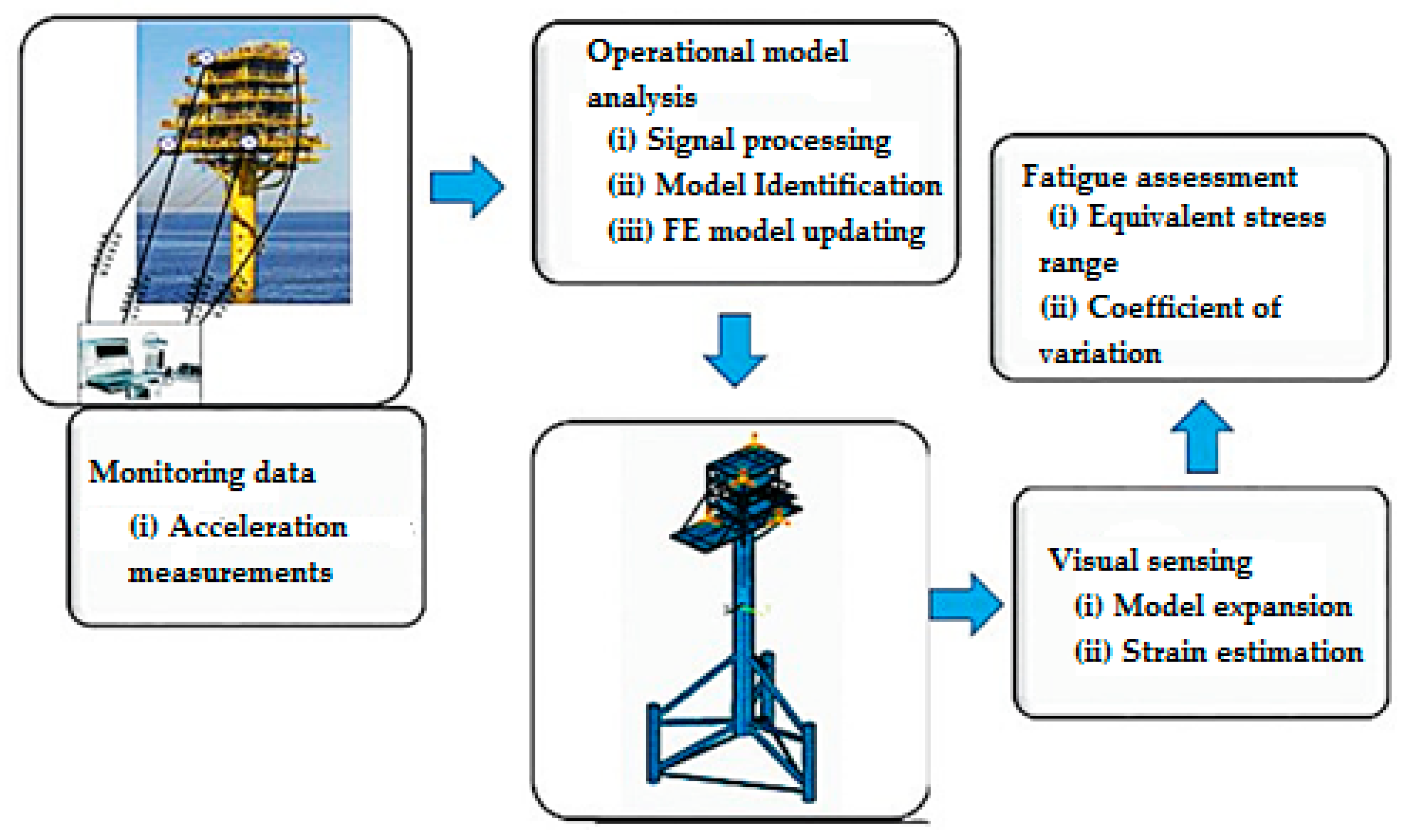

| Author | Year | Method | Results |
|---|---|---|---|
| Hosseini and Zolghadr [29] | 2017 | Metaheuristic algorithm, namely cyclical parthenogenesis algorithm (CPA) | Minimum weight jacket-type |
| Zhang et al. [30] | 2018 | Tension leg platform (TLP) optimization program (multi-objective optimization) | Maximum dynamic tension and the total weight of the platform |
| El-Makarem et al. [31] | 2019 | Automated optimization method (automated iterative method of gradually topology optimization) | Safe structure during earthquake event with a minimum total weight |
| Tian et al. [32] | 2019 | Topology optimization method | Maximize the structural stiffness |
| Deng et al. [33] | 2020 | Topology optimization method | The maximum stiffness considering wind, wave, and ice loads |
| Babaei et al. [34] | 2021 | Probabilistic seismic demand analysis (PSDA) | Intensity measures (Ims) and engineering demand parameters (EDPs) |
| Author | Year | Method | Results |
|---|---|---|---|
| Zhang et al. [40,41,42] | 2005–2013 | Delayed non-fragile | Vibration reduction The smaller control forces Better control performance |
| Zhang and Han [43] | 2013 | Robust sliding mode | Effects of time-varying delays on robust sliding mode control |
| Yang [44] | 2014 | Robust mixed / control | Minimization of the upper bound of the performance measure Improvement of dynamic performances |
| Sakthivel et al. [45] | 2015 | Robust fault-tolerant sampled-data (control forces) | The safety and comfort level of the offshore structure Better effectiveness |
| Zhang et al. [46] | 2016 | Event-triggered with the network-based modeling | Guaranteeing the stability Saving the communication resources Less control cost than simple controllers () |
| Author | Year | Method and Condition | Results |
|---|---|---|---|
| Kurian et al. [65] | 2013 | Pushover analysis Bayesian updating theory for updating the failure probability | Maximum environmental load |
| Ayob et al. [66] | 2014 | Pushover analysis Global ultimate strength assessment Simplified structural reliability analysis | Optimum mitigation measures Different failure modes Maximum environmental load |
| Li et al. [67] | 2016 | The damage control methods | The rib reinforcement can slow down the structural damage |
| Yu et al. [68] | 2019 | The ice-induced steady-state vibration mechanism analysis | The mechanism of failure The failure criteria |
| Lin et al. [69] | 2019 | Path-dependent and state-dependent robustness index Structural overall dynamic robustness index Structural comprehensive robustness index Bearing-capacity-ratio method combined with the incremental-loading method | Structural robustness assessment Determining all possible failure paths Robustness changes in different failure paths are different so that an unintended accident in small probability paths has a severe effect on structural robustness |
| Moradi et al. [70] | 2020 | Pushover analysis The legs slope of jacket platforms | The improvement of safety factors and platform behavior |
Publisher’s Note: MDPI stays neutral with regard to jurisdictional claims in published maps and institutional affiliations. |
© 2021 by the authors. Licensee MDPI, Basel, Switzerland. This article is an open access article distributed under the terms and conditions of the Creative Commons Attribution (CC BY) license (https://creativecommons.org/licenses/by/4.0/).
Share and Cite
Amiri, N.; Shaterabadi, M.; Reza Kashyzadeh, K.; Chizari, M. A Comprehensive Review on Design, Monitoring, and Failure in Fixed Offshore Platforms. J. Mar. Sci. Eng. 2021, 9, 1349. https://doi.org/10.3390/jmse9121349
Amiri N, Shaterabadi M, Reza Kashyzadeh K, Chizari M. A Comprehensive Review on Design, Monitoring, and Failure in Fixed Offshore Platforms. Journal of Marine Science and Engineering. 2021; 9(12):1349. https://doi.org/10.3390/jmse9121349
Chicago/Turabian StyleAmiri, Nima, Mohammad Shaterabadi, Kazem Reza Kashyzadeh, and Mahmoud Chizari. 2021. "A Comprehensive Review on Design, Monitoring, and Failure in Fixed Offshore Platforms" Journal of Marine Science and Engineering 9, no. 12: 1349. https://doi.org/10.3390/jmse9121349
APA StyleAmiri, N., Shaterabadi, M., Reza Kashyzadeh, K., & Chizari, M. (2021). A Comprehensive Review on Design, Monitoring, and Failure in Fixed Offshore Platforms. Journal of Marine Science and Engineering, 9(12), 1349. https://doi.org/10.3390/jmse9121349








